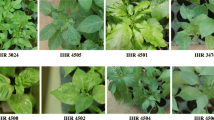Abstract
In India, chilli leaf curl disease (ChiLCD) is emerging as the most destructive threat for chilli production, with its drastic effect on fruit yield and quality. In the present study, we report the molecular characterization of a virulent virus isolate associated with ChiLCD prevalent in Raichur, Karnataka State, India. The complete genome sequencing of the virus isolate exhibited 99.5% sequence identity to ChiLCV-IN [IN:Ahm:09] DNA-A and 98% sequence identity to Tomato leaf curl Bangladesh beta satellite infecting chilli. To identify a durable resistant source, we evaluated 238 chilli genotypes for resistance to the chilli leaf curl virus ChiLCV-Raichur (ChiLCV-Rai) isolate through mass and individual cage inoculation methods using virulent whiteflies. Three Capsicum annuum L. accessions, namely IHR4517, IHR4615, and IHR4630 were found to be highly resistant, which was further confirmed using graft inoculation and PCR. Furthermore, inheritance of resistance was studied, and segregation analysis demonstrated the best fit ratio of 3:1 and 1:1 in F2 and test cross populations, respectively indicating single dominant gene control resistance against the ChiLCV-Rai isolate in two highly resistant lines, namely IHR4517 and IHR4615. These genotypes can be further exploited in the development of ChiLCD-resistant varieties/F1 hybrids.




Similar content being viewed by others
References
Ahmad A, Sharma A, Zehra SB, Kang SS, Bhat M, Hussain A (2016) Evaluation of chilli genotypes against Chilli leaf curl virus. Indian J Ecol 43:144–147
Anonymous (2017) Horticultural Statistics at a Glance. National Horticulture Board. Ministry of Agriculture and Farmers Welfare, Government of India
Bal SS, Singh J, Dhanju KC (1995) Genetics of resistance to mosaic and leaf curl viruses in chilli (Capsicum annuum L.). Indian J Virol 11:77–79
Bhatt BS, Chahwala FD, Rathod S, Singh AK (2016) Identification and molecular characterization of a new recombinant begomo virus and associated beta satellite DNA infecting Capsicum annuum in India. Arch Virol 161:1389–1394
Bos L (1982) Crop losses caused by viruses. Crop Prot 1:263–282
Briddon RW, Bull SE, Mansoor S, Amin I, Markham PG (2002) Universal primers for the PCR-mediated amplification of DNA β. Mol Biotechnol 20:315–318
Chattopadhyay B, Singh AK, Yadav T, Fauquet CM, Sarin NB, Chakraborty S (2008) Infectivity of the cloned components of a begomovirus: DNA-b complex causing chilli leaf curl disease in India. Arch Virol 153:533–539
Dhaliwal MS, Jindal SK, Cheema DS (2015) CH-27: a multiple disease resistant chilli hybrid. Agric Res J 52:127–129
Doyle JJ, Doyle JL (1990) Isolation of plant DNA from fresh tissue. Focus 12:13–15
Gomez P, Rodriguez-Hernandez AM, Moury B, Aranda MA (2009) Genetic resistance for the sustainable control of plant virus diseases: breeding, mechanisms and durability. Eur J Plant Pathol 125:1–22
Hussain MS, Naveed K, Atiq M (2017) Susceptibility of chilli lines/varieties towards chilli leaf curl virus and its management through vector control. Pak J Phytopathol 29:17–22
Kumar S, Kumar R, Kumar S, Singh M, Rai AB, Rai M (2009) Reaction of Pepper leaf curl virus field resistance of chilli (C. annuum L.) genotypes under challenged condition. Veg Sci 36:230–232
Kumar RV, Singh AK, Singh AK, Yadav T, Basu S, Kushwaha N (2015) Complexity of begomo virus and beta satellite populations associated with chilli leaf curl disease in India. J Gen Virol 96:3143–3158
Olawale A, Samuel BO, Solomon ASO, Kumar PL (2015) Surveys of virus diseases on pepper (Capsicum spp.) in South-west Nigeria. Afr J Biotechnol 14:3198–3205
Padhi GK, Maity L, Chattopadhyay A, Samanta A (2017) Population dynamics of whitefly (Bemisia tabaci Genn.) in chilli and screening of genotypes against chilli leaf curl virus. J Ent Zool Stud 5:104–107
Rai VP, Kumar R, Singh SP, Kumar S, Kumar S, Singh M (2014) Monogenic recessive resistance to Pepper leaf curl virus in an interspecific cross of Capsicum. Sci Hortic 172:34–38
Rishi N (2004) Current status of begomoviruses in the Indian subcontinent. Indian Phytopathol 57:396–407
Senanayake DMJB, Mandal B, Lodha S, Varma A (2007) First report of Chilli leaf curl virus affecting chilli in India. Plant Pathol 56:343
Sharma A, Jindal SK, Thakur H (2018) Phenotypic classes of leaf curl virus disease severity for nursery screening in chilli pepper. Plant Dis Res 33:99–103
Snedecor GW, Cochran WG (1967) Statistical methods, 6th edn. Iowa State College Press, Ames
Srivastava A, Mangal M, Saritha RK, Jat SL, Gosavy GU, Kalia P (2015) Natural epiphytotic screening of chilli germplasm lines against Leaf curl virus complex. Int J Trop Agric 33:3581–3586
Thakur H, Jindal SK, Sharma A, Dhaliwal MS (2019) A monogenic dominant resistance for leaf curl virus disease in chilli pepper (Capsicum annuum L.). Crop Prot 116:115–120
Venkataravanappa V, Reddy CNL, Jalali S, Reddy MK (2012) Molecular characterization of distinct bipartite begomoviruse infecting bhendi (Abelmoschus esculentus L.) in India. Virus Gen 44:522–535
Acknowledgements
Authors acknowledge Director, ICAR-Indian Institute of Horticultural Research, Bengaluru for providing research facilities and University Grants Commission, Government of India for providing fellowship for the Ph.D. study to Mr. Rajeev Kumar Yadav.
Funding
This work was supported by the research grants provided under ICAR-Consortium Research Plat form on Vaccines and Diagnostics.
Author information
Authors and Affiliations
Corresponding author
Ethics declarations
Conflict of interest
The authors declare no conflict of interest.
Additional information
Publisher’s Note
Springer Nature remains neutral with regard to jurisdictional claims in published maps and institutional affiliations.
Supplementary Information
Below is the link to the electronic supplementary material.
Rights and permissions
About this article
Cite this article
Yadav, R.K., Reddy, K.M., Ashwathappa, K.V. et al. Screening of Capsicum germplasm and inheritance of resistance to chilli leaf curl virus. Indian Phytopathology 75, 1129–1136 (2022). https://doi.org/10.1007/s42360-022-00530-8
Received:
Revised:
Accepted:
Published:
Issue Date:
DOI: https://doi.org/10.1007/s42360-022-00530-8




